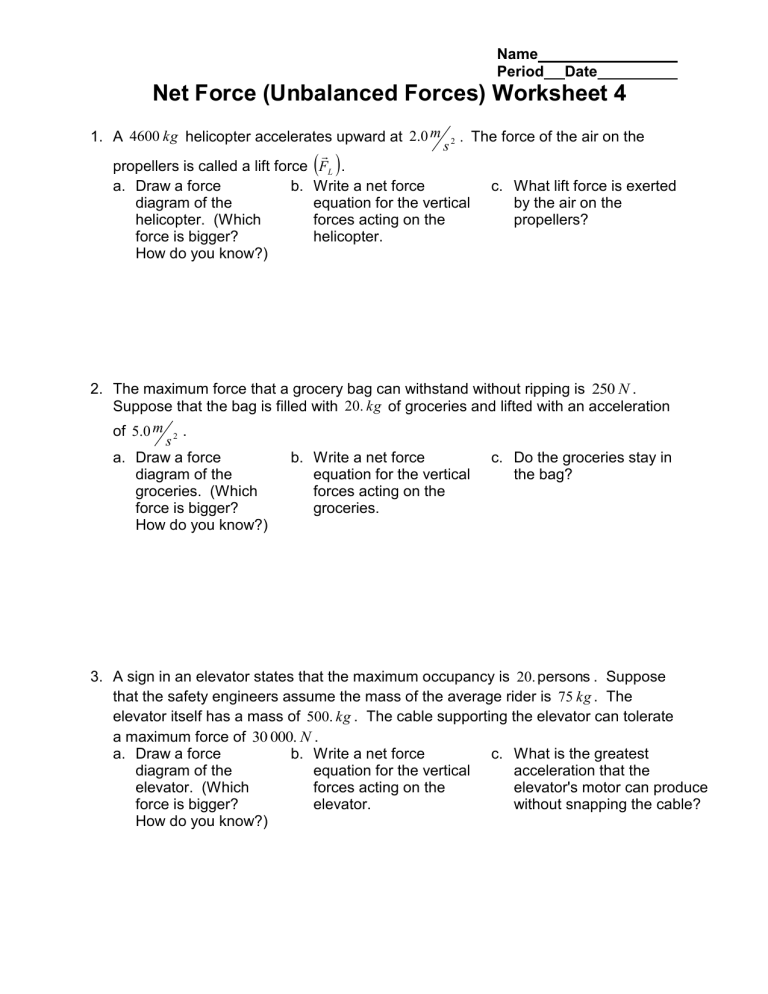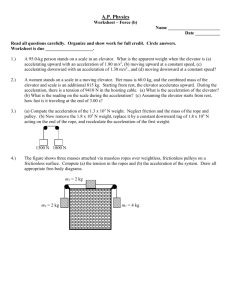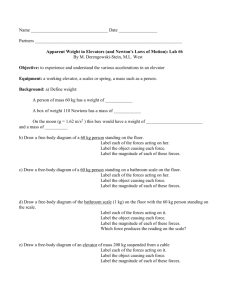Net Force Worksheet 4
advertisement

Name Period Date Net Force (Unbalanced Forces) Worksheet 4 1. A 4600 kg helicopter accelerates upward at 2.0 m 2 . The force of the air on the s propellers is called a lift force FL . a. Draw a force b. Write a net force c. What lift force is exerted diagram of the equation for the vertical by the air on the helicopter. (Which forces acting on the propellers? force is bigger? helicopter. How do you know?) 2. The maximum force that a grocery bag can withstand without ripping is 250 N . Suppose that the bag is filled with 20. kg of groceries and lifted with an acceleration of 5.0 m 2 . s a. Draw a force b. Write a net force c. Do the groceries stay in diagram of the equation for the vertical the bag? groceries. (Which forces acting on the force is bigger? groceries. How do you know?) 3. A sign in an elevator states that the maximum occupancy is 20. persons . Suppose that the safety engineers assume the mass of the average rider is 75 kg . The elevator itself has a mass of 500. kg . The cable supporting the elevator can tolerate a maximum force of 30 000. N . a. Draw a force b. Write a net force c. What is the greatest diagram of the equation for the vertical acceleration that the elevator. (Which forces acting on the elevator's motor can produce force is bigger? elevator. without snapping the cable? How do you know?) Net Force (Unbalanced Forces) Worksheet 4 page 2 Problems #4 – 7 require you to use the kinematic equations as well as Newton's 2nd Law. The variable that ties both the kinematic equations and Newton’s 2 nd Law together is acceleration. Depending on the variables you know, use either the net force equation or the kinematic equations to solve for acceleration, and then use the acceleration value to solve for the unknown quantity. Remember, the kinematic equations are v vo at 1 x x0 v v o t 2 1 x xo vo t at 2 2 2 2 v v o 2a x x o 4. A race car has a mass of 710 kg . It starts from rest and travels 40.0 m in 3.0 s . The car is uniformly accelerated during the entire time. a. What is the car’s acceleration? b. What net force is acting on the car? c. Draw a force diagram for the car. It will have a forward applied force from the road and a force of friction/drag opposing its motion. d. Write the net force equation for the horizontal forces. If the total frictional force acting on the car is 1500. N, what applied force is acting on the car? 5. Suppose that a 1000. kg car is traveling at 25.0 m a force of 5000. N . a. Draw a force diagram of the car as it slows to a stop. s 55mph when its brakes apply b. Write the net force equation for the axis along which the forces are not balanced, and then calculate the acceleration of the car. c. What is the minimum distance required for the car to stop? Net Force (Unbalanced Forces) Worksheet 4 page 3 6. A 900. kg car exerts 5000. N of force on a level road while being opposed by 1000. N of friction and drag forces combined. a. Draw a force b. Write the net force c. If the car starts from diagram for the car. equation for the axis rest, how long will it take along which the forces it to accelerate to are not balanced and 26.8 m 60 mi ? h s then calculate the acceleration of the car. 7. During a head-on collision, a passenger in the front seat of a car accelerates from 13.3 m 30mph to rest in 0.100 s . s a. What is the b. Draw a force c. The driver of the car holds out his acceleration of diagram of the arm trying to keep his 25.0 kg the passenger? passenger. child (who is not wearing a seat belt) from smashing into the dashboard. What force must he exert on the child? d. What is the weight of the child? e. Convert the forces in (c) and (d) from 1 lb. N to lbs. . What are the 4.45 N chances the driver will be able to stop the child?







